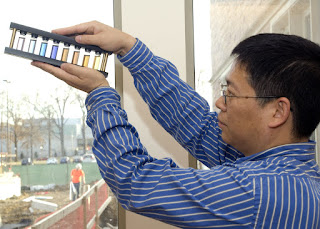'Good as gold': Information obtained from a new application of photoacoustic tomography (PAT) is worth its weight in gold to breast cancer patients.
For the first time, Lihong Wang, Ph.D., Gene K. Beare Distinguished Professor in the Department of Biomedical Engineering, with a joint appointment in Radiology, and Younan Xia, Ph.D., James M. McKelvey Professor in Biomedical Engineering, with a joint appointment in chemistry in Arts & Sciences, both at Washington University in St. Louis, have used gold nanocages to map sentinel lymph nodes (SLN) in a rat noninvasively using PAT. Wang's lab is the largest PAT lab in the world credited with the invention of super-depth photoacoustic microscopy, and Xia's lab invented the gold nanocages.
"Using pure optical imaging, it is hard to look deep into tissues at high resolution because light scatters. The useful photons run out of juice within 1mm," Wang explained. "PAT improves tissue transparency by 2-3 orders of magnitude because sound scatters less than light. This allows us to see through the tissue by listening to the sound."
The SLN, the first draining node, is often biopsied in breast cancer patients to determine if the cancer has metastasized. "To find the SLN, doctors inject radioactive particles and a blue dye into the breast. The lymphatic system gobbles up the injected material, treating it as foreign matter and accumulating it in the SLN. The radioactive particles can be detected using a Geiger counter held to the breast to locate the lymph nodes. Then, the doctors surgically open the breast, follow the blue dye, and dissect the SLN," Wang said.
Wang and Xia's technique allows the SLN to be imaged safely without radioactivity or surgery. A piece of tissue can then be removed using a minimally invasive needle biopsy and tested for cancer. "We will convert an invasive surgical procedure into a minimally invasive needle biopsy," Wang said. ###
The work was supported by the National Institutes of Health.
In the future, they hope to attach molecules to the surface of the gold nanocages that will selectively bind to cancer cells, making a "smart contrast agent." Then, the nanocages will only be detected where cancer is present, eliminating the need for a needle biopsy.
Written by: Melissae Stuart
Contact: Lihong Wang lhwang@wustl.edu 31-493-593-56152 Washington University in St. Louis

















No comments:
Post a Comment